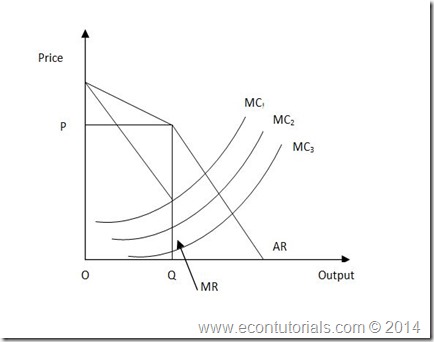Forms of Oligopoly
There are two forms of oligopoly structure;
i. Collusive Oligopoly: In such oligopoly few firms unite together through a formal or informal agreement. The example for formal agreement is cartels and the example for informal agreement is price leadership model.
ii. Non-Collusive Oligopoly: If the firm takes its decision of price setting and output level independently without any mutual understanding or without collaboration with any other firm then such oligopolistic firm is non-collusive.
Portions of Kinked Demand Curve
In case of non-collusive oligopoly firm the demand curve have two portions;
i. Elastic Portion: It such portion of demand curve which is above prevailing price level. This portion of demand curve shows that if an oligopolistic firm increases its price the other firms will not increase their prices.
ii. Inelastic Portion: It is such portion of demand curve which is below prevailing price level. The inelastic portion of demand curve implies that if the firm decreases its price the other firms will also decrease their prices in order to attract maximum customers.
Competition Factors
These elastic and inelastic portions of demand curve form kick. Due to this in oligopoly market structure several firms compete with each other for greater share of the market. They compete with each other in terms of:
· Quality
· Product Design
· Advertisement, and
· Services
Explanation
In non-collusive oligopoly if a firm decreases the other firms in the market will also decrease its price. This is called price war. Whereas, if the firm increases its price the other firms will not increase their price rather they keep their prices intact in order to attract maximum customers and to gather greater portion of market. Due to this a kick is formed in demand. It does not remain straightly sloped; rather it divides in two portions. One is highly elastic and other is highly inelastic.
In such situation a firm will remain reluctant to change its price because other firms under competition will follow its decision if it decreases its price and the other firms will ignore its decision if it increases its price. Due to this a firm loses its optimal level of production which is profit maximization level of output. Due to this the firm keeps its price constant irrespective of the increase in its marginal cost. Such price level is regarded as prevailing price.
Where there is non-collusive oligopoly the marginal revenue curve is broken down into two portions. One is variable portion and the other is fixed portion. An oligopolistic firm will remain on fixed portion. Any increase or decrease in marginal cost becomes irrelevant for the oligopolistic firm. By any change in the cost of production the firm is not interested to change its price. Such circumstances are regarded as price rigidity or sticky price.
In case of kicked demand curve the price and output of an oligopoly firm becomes stable. With this stability if the cost changes of the oligopoly firm, due to which the marginal cost curve also changes, will not at all effects the output and price of the oligopoly firm.



